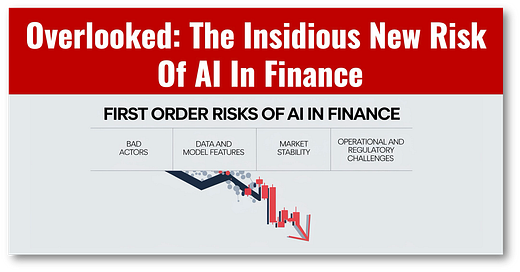Overlooked: The Insidious New Risk Of AI In Finance
No one knows what will happen when AI systems interact.
AI is seen as a panacea for markets, with AI agents automatically doing our bidding on traded markets. While that sounds great, the result of AIs making decisions in concert is unknown and understudied.
The SEC recently declared that “AI deployment in portfolio management may result in more violent market swings as financial algorithms move together.”
This shouldn’t come as a surprise, and it's just a matter of time before AIs cause a market disruption, like algorithmic trading caused flash crashes in 2010.
If you enjoy this article, subscribe!
While we may understand how an individual AI works and declare it benign, we can’t be sure how it will interact. We’ll have to wait for the crash or disruption to understand better what caused it.
The sad truth is that, like Elon Musk’s SpaceX, or airplanes, we’ll have to crash a few times in order to learn.
👉First and second-order effects of AI in finance:
FIRST ORDER:
Bad actors
🔹Scams and impersonations: Generative Al techniques could be used for 'deepfake voice and video technology.
🔹Cybersecurity threats: Al-powered cybersecurity attacks may lead to an arms race between protective Al-driven measures that aim to stamp out cyberattacks.
🔹Market manipulation: Al could be a powerful tool for disinformation, misleading investors or consumers.
Data and model features
🔹Privacy concerns
Models may be trained on datasets that include sensitive financial and non-financial data, increasing the need for privacy protections.
🔹Lack of explainability
Many Al models are opaque, posing challenges for regulators and institutions that need to understand the rationale for sensitive decisions.
🔹Al biases
Al datasets or algorithms can be biased, producing skewed outcomes that inaccurately disadvantage certain groups.
Market stability
🔹Algorithmic convergence and market instability
Market participants relying on similar Al models in asset allocation and portfolio management may increase trading correlations and volatility, and lead to herding behaviour, raising the risk of destructive events like flash crashes.
Operational and Regulatory Challenges
🔹Concentration and third-party reliance
Reliance on a small number of firms and key geographic locations in the Al supply chain could create concentrated operational risks for financial institutions, with implications for wider system stability.
🔹Regulatory challenges
Rapid technological advances may outpace regulators' ability to respond. Regulatory approaches may diverge, increasing costs and uncertainty for financial institutions, and widening opportunities for regulatory arbitrage.
SECOND ORDER:
🔹Disrupting insurance economics AI’s ability to improve the quality of predictions may disrupt insurance markets, potentially making insurance more expensive for high-risk individuals or businesses.
🔹Labour market disruption and inequality AI may cause labour market polarisation by displacing middle-wage workers through skill-biased technological change.
🔹Erosion of economic indicators The hollowing out of middle-wage work contributes to the erosion of the Phillips curve and a decline in real equilibrium interest rates.






